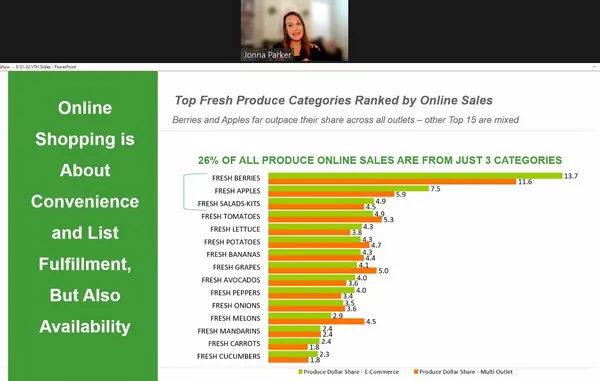Undoubtedly, the pandemic escalated consumers' comfort levels with online shopping. However, yesterday's International Fresh Produce Association's Virtual Town Hall took a closer look at the ways retail technology could help drive the consumption of fresh produce particularly.
Jonna Parker, principal for IRI Fresh Foods, kicked off the session by looking at where consumers are at today with online shopping. As she noted, 11.7 percent of all retail food and beverages are sold online, a figure that includes produce. It's happened in food service as well in 2019, and Parker noted that six percent of all commerce for restaurants was done online. Now, that figure sits at 14.6 percent. "That's almost 15 percent of all restaurant traffic coming only through digital means," she said. "Our future growth is coming from online now."
As she notes, Amazon is 11 percent of all omnichannel purchasing of food, beverages, and groceries. "That doesn't mean that Amazon is killing it in produce. However, if you're used to going online for almost anything else in your life, why wouldn't you start thinking about going online for produce?" she asked." The reality is that digital and other players have reshaped the landscape for fresh foods."
 Left to right: Jonna Parker, Heather Paquette
Left to right: Jonna Parker, Heather Paquette
Berries are online produce leader
Of the produce being purchased, berries are the leader in fresh produce consumption, followed closely behind by apples and fresh bag salad kits. "What's remarkable is when it comes to produce sales online, more than a quarter of all produce sold in the digital e-commerce space comes from those three categories," she said.
Parker also noted the importance of digital shopping and the next generation of shoppers. Shoppers under 40 spend 1.2 times more on fresh foods online than their generational counterparts. "When a person under the age of 40 buys produce online, they spend 22 percent more on produce online than in-store. Not only are they more digitally native, but they're also more willing to commit and upgrade online as well," she said. "This generation is digitally native. It's a fluid environment for younger consumers, and the more we can make the online and in-store environment seamless, the better."
That includes the way food is marketed and sold. With Millennials and Gen Z, almost one in five of them have found a product they love and regularly buy because of social media. (Compare that with 1/2 or less than 10 percent of Baby Boomers or Generation X.) "So what you do online will change how they shop, and it's more than changing a display or putting up a sign," Parker said. "We've seen this in fresh foods that have gone viral and have a direct impact on in-store sales. Watermelon and mustard, for example--it was a thing on social media this summer, and it drove a lot of sales of watermelon this year amongst younger people."
Improving the customer experience
The conversation then turned to the panel, and Heather Paquette, vice-president, Retail Innovation Center of Excellence at Retail Business Services, started off talking about how retailers are shifting to deliver more value to customers and allowing them to pick the experience they want, whether that's click and delivery, online shop and pick up more items upon collection and more.
 Left to right: Dorn Wenninger, David Steck
Left to right: Dorn Wenninger, David Steck
"We're really focusing on what we've heard loud and clear from customers, and that is they absolutely value having associate interactions, and they want our associates to be to be present to help them solve problems or assist them with their shopping experience as needed," Paquette said. That means focusing the associates' time on customer-facing activities and using retail technology to handle redundant non-customer-facing activities. This may include technology such as bathroom cleaning machines, automation of delivery, product slicing, and even self-checkout.
This is even more important considering the tightness of the current labor market. "Right now, our associates are very precious to us. I can't imagine there are a lot of retailers who feel they have an abundance of labor," said Paquette.
Technology and the labor pool
For David Steck, VP, IT infrastructure & application development, Schnuck Markets, Inc., retail technology that is of interest are developments such as electronic shelf labels. "Heather is right in that labor is precious now. With dwindling labor pools, as hard as you may try to get all those shelf tags hung every week, you're going to miss some, and that affects the whole shopping experience," he said.
It's also technology that empowers associates to help customers. "We had associates in produce tell us to help a customer. They would use their personal cell phone to pull up a video about how to cut dragonfruit," said Steck. "How do we provide our associates' tools to help?"
Other retail technologies under consideration are Amazon-style technology, where consumers' grocery carts are empowered by camera technology and scales, which make for a touchless checkout, or even in-store shoppers armed with camera technology to help select produce items.

"Less sexy" technology
Reiterating Paquette's notion of improving customer-facing experiences, Dorn Wenninger, senior vice-president of produce, United Natural Foods, Inc., pointed out that sometimes the technology being considered is less "sexy." "So some of the technology is used to reduce labor all the way through the supply chain," Wenninger said. "I was in Peru last week where they used automated pallet machines to build pallets. It's a simple technology that's been around forever, and I think it's going to be more prolific. It's working creatively to take the noise from the floor and allow associates to give the consumer what they want, which is a fresh product."
At the same time, technology has also made for some battles between online and in-store trends. Wenninger pointed to in-store shopping often featuring variable-weight items and e-commerce sales with fixed-weight items. "These are conflicting trends. One trend is to have less packaging, and the other is selling in packaging. How do we thread the needle on both of these trends?" he asked.
Parker concluded the session by also stressing the importance of the personal experience in store. "The majority of folks who are Millennials and Gen. Z. do not know how to pick a ripe cantaloupe. They trust their store associate more and aren't of the generation necessarily where their mom or grandma showed them how to pick ripe fruit in the store," she says.
